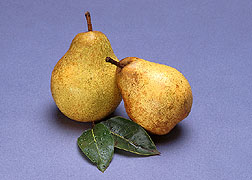This page has been archived and is being provided for reference purposes only. The page is no longer being updated, and therefore, links on the page may be invalid.
A Dwarf Pear Tree: Another Genetic Engineering FirstBy Judy McBrideJuly 2, 1999 The first genetically engineered dwarf pear tree of an existing variety has been developed by Agricultural Research Service scientists. Dwarf trees are more productive than traditional-size trees and offer growers other advantages as well. ARS horticulturists Ralph Scorza and Richard Bell at the Appalachian Fruit Research Station in Kearnesyville, WV, dwarfed Bosc pear trees by inserting a gene originally isolated from a bacterium. The new dwarf trees are growing in greenhouses at the lab, and the scientists expect the trees to bear fruit in about two or three years. The bacterial gene can be used to dwarf rootstocks or to make the scion—the top part of the tree—smaller or dwarf. According to Bell, the pear industry relies on only a few major varieties and needs to improve them. Dwarfing will do that. In addition to being more productive, dwarf fruit trees allow high-density plantings of smaller trees that can produce more fruit in the same area of land than the larger, standard-size trees. And they’re easier to manage, prune, spray and harvest. Fruit from a dwarf tree is the same size as fruit from a normal tree. For those growers not interested in dwarf trees, Scorza and colleagues have developed a peach tree with a new, columnar shape. Perfect for the home gardener with limited space, the columnar tree has upright, narrow branches that grow close to the tree trunk without shading other fruit or vegetables that may be growing nearby. Like dwarfs, the columnar trees require much less management and will allow high-density growing. They eliminate the large space necessary between traditional trees. Therefore, chemicals and fertilizer need be applied only to a very small area, saving the grower money and reducing environmental impacts. Compared to traditional size trees, at least three times as many columnar trees can be grown per unit of land. These new trees—which bear excellent quality fruit—are expected to be available to home gardeners within the next few years. ARS is USDA’s chief scientific research agency. A more detailed story on this research is available in the agency’s July Agricultural Research magazine, available on the Internet at: /is/AR/archive/jul99/fruits0799.htm Scientific contact: Ralph Scorza and Richard Bell, ARS Appalachian Fruit Research Station, Kearneysville, W.Va.; fax (304) 728-2340; phone (304) 725-3451, Scorza (Ext. 322), Bell (Ext. 353), rscorza@afrs.ars.usda.gov, rbell@afrs.ars.usda.gov. |

